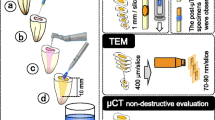Abstract
AIM: This was to investigate the nanoleakage of Resin Modified Glass Ionomer Cement (RMGIC) and composite resin (CR) restorations in sound and caries-affected primary dentine, submitted to load cycling and cariogenic challenge in vitro. METHOD: Occlusal cavities were prepared in 60 sound exfoliated primary second molars and 30 specimens were subjected to chemical induction of artificial caries lesions and the others were restored without caries induction. All prepared teeth were divided into 2 groups according to restorative materials. From each dentine condition 5 restored teeth and restorative material were subjected to microtensile bond strength and nanoleakage tests immediately or after load-cycling or submitted to the pH-cycling procedure before testing. RESULTS: The adhesive presented bigger areas of silver leakage at the interfaces on caries-affected dentine (2.46±0.47)mm2 than sound dentine (0.90±0.19)mm2. RMGIC nanoleakage was not influenced by the sound (1.75±0.11)mm2or caries-affected (2.08±0.39) condition of the substrate. A significant moderate inverse correlation was revealed between the bond strength and silver leakage area at the interface, (r= −0.55, p<0.001). CONCLUSIONS: Nanoleakage is greater in caries-affected primary teeth dentine than sound dentine in adhesive restorations although at the interfaces of RMGIC does not differ. As nanoleakage increases, bond strength decreases significantly.
Similar content being viewed by others
References
Breschi L, Mazzoni A, Ruggeri A, et al. Dental adhesion review: ageing and stability of the bonded interface. Dent Mater 2008; 24:90–101.
Carrilho MR, Geraldeli S, Tay FR, et al. In vivo preservation of the hybrid layer by chlorhexidine. J Dent Res 2007; 86:529–33.
De Munck J, Van Landuyt K, Peumans M, et al. A critical review of the durability of adhesion to tooth tissue: methods and results. J Dent Res 2005; 84:118–32.
Ding PG, Wolff D, Pioch T, Staehle HJ, Dannewitz B. Relationship between microtensile bond strength and nanoleakage at the composite-dentin interface. Dent Mater 2009; 25:135–41.
Erhardt MC, Rodrigues JA, Valentino TA, Ritter AV, Pimenta LA. In vitro microTBS of one-bottle adhesive systems: Sound versus artificially-created caries-affected dentin. J Biomed Mater Res B Appl Biomater. 2008 Jul; 86:181–7.
Hashimoto M, Ohno H, Kaga M, et al. In vivo degradation of resin-dentin bonds in humans over 1 to 3 years. J Dent Res 2000; 79:1385–91.
Hashimoto M, De Munck J, Ito S, et al. In vitro effect of nanoleakage expression on resin-dentin bond strengths analyzed by microtensile bond test, SEM/EDX and TEM. Biomaterials 2004; 25:5565–74.
Hebling J, Pashley DH, Tjaderhane L, Tay FR. Chlorhexidine Arrests Subclinical Degradation of Dentin Hybrid Layers in vivo. J Dent Res 2005; 84:741–6.
Li H, Burrow MF, Tyas MJ. The effect of load cycling on the nanoleakage of dentin bonding systems. Dent Mater 2002; 18:111–9.
Mendes FM, Nicolau J. Utilization of laser fluorescence to monitor caries lesions development in primary teeth. ASDC J Dent Child 2004; 71:139–42.
Navarra CO, Cadenaro M, Codan B, et al. Degree of conversion and interfacial nanoleakage expression of three one-step self-etch adhesives. Eur J Oral Sci 2009; 117:463–9.
Neelakantan P, Sanjeev K, Rao CV. Ultramorphological characterization of the resin dentin interface—an in vitro analysis of nanoleakage patterns of dentin adhesives. J Clin Pediatr Dent 2009; 33:223–30
Okuda M, Pereira PN, Nakajima M, Tagami J, Pashley DH. Long-term durability of resin dentin interface: nanoleakage vs. microtensile bond strength. Oper Dent 2002; 27:289–96.
Osorio R, Ceballos L, Tay FR, Cabrerizo-Vilchez MA, Toledano M. Effect of sodium hypochlorite on dentin bonding with a polyalkenoic acid-containing adhesive system. J Biomed Mater Res 2002; 60:316–24.
Pashley DH, Tay FR, Yiu C, et al. Collagen degradation by host-derived enzymes during ageing. J Dent Res 2004; 83:216–21.
Pereira PN, Sano H, Ogata M, et al. Effect of region and dentin perfusion on bond strengths of resin-modified glass ionomer cements. J Dent 2000; 28:347–54.
Reis AF, Arrais CA, Novaes PD, et al. Ultramorphological analysis of resin-dentin interfaces produced with water-based single-step and two-step adhesives: nanoleakage expression. J Biomed Mater Res B Appl Bio-mater 2004; 71:90–8.
Reis A, Grande RH, Oliveira GM, Lopes GC, Loguercio AD. A 2-year evaluation of moisture on microtensile bond strength and nanoleakage. Dent Mater 2007a; 23:862–70.
Reis AF, Giannini M, Pereira PN. Long-term TEM analysis of the nanoleakage patterns in resin-dentin interfaces produced by different bonding strategies. Dent Mater 2007b; 23:1164–72.
Ricci HA, Sanabe ME, de Souza Costa CA, Pashley DH, Hebling J. Chlorhexidine increases the longevity of in vivo resin-dentin bonds. Eur J Oral Sci. 2010;118:411–6.
Rocha RO, Soares FZ, Rodrigues Filho LE, Rodrigues CR. Influence of ageing treatments on microtensile bond strength of adhesive systems to primary dentin. ASDC J Dent Child 2007; 74:109–12.
Sano H, Shono T, Takatsu T, Hosoda H. Microporous dentin zone beneath resin-impregnated layer. Oper Dent 1994; 19:59–64.
Sano H, Takatsu T, Ciucchi B, Horner JA, Matthews WG, et al. Nanoleakage: leakage within the hybrid layer. Oper Dent 1995; 20:18–25.
Tay FR, Hashimoto M, Pashley DH, et al. Ageing affects two modes of nanoleakage expression in bonded dentin. J Dent Res 2003; 82:537–41.
Tay FR, Pashley DH, Yoshiyama M. Two modes of nanoleakage expression in single-step adhesives. J Dent Res 2002a; 81:472–6.
Tay FR, Pashley DH, Suh BI, Carvalho RM, Itthagarun A. Single-step adhesives are permeable membranes. J Dent 2002b; 30:371–82.
Tay FR, King NM, Chan KM, Pashley DH. How can nanoleakage occur in self-etching adhesive systems that demineralize and infiltrate simultaneously? J Adhes Dent 2002c; 4:255–69.
Author information
Authors and Affiliations
Corresponding author
Rights and permissions
About this article
Cite this article
Marquezan, M., Skupien, J.A., da Silveira, B.L. et al. Nanoleakage related to bond strength in RM-GIC and adhesive restorations. Eur Arch Paediatr Dent 12, 15–21 (2011). https://doi.org/10.1007/BF03262773
Published:
Issue Date:
DOI: https://doi.org/10.1007/BF03262773




